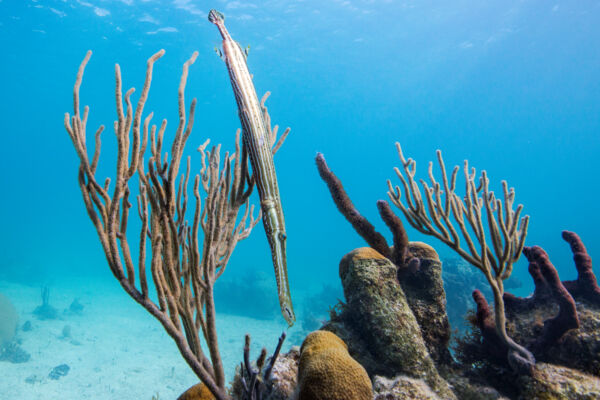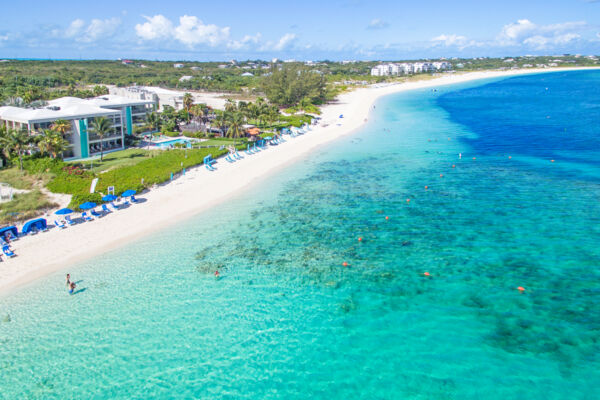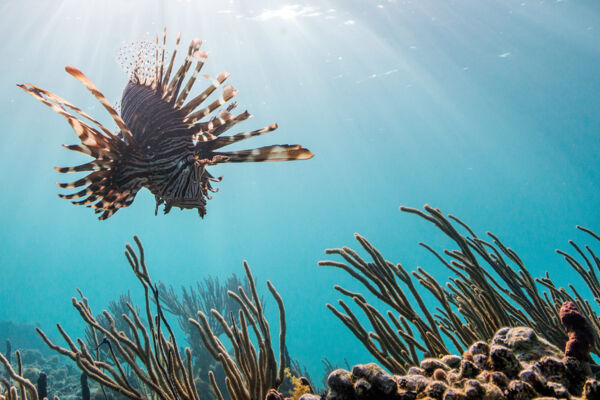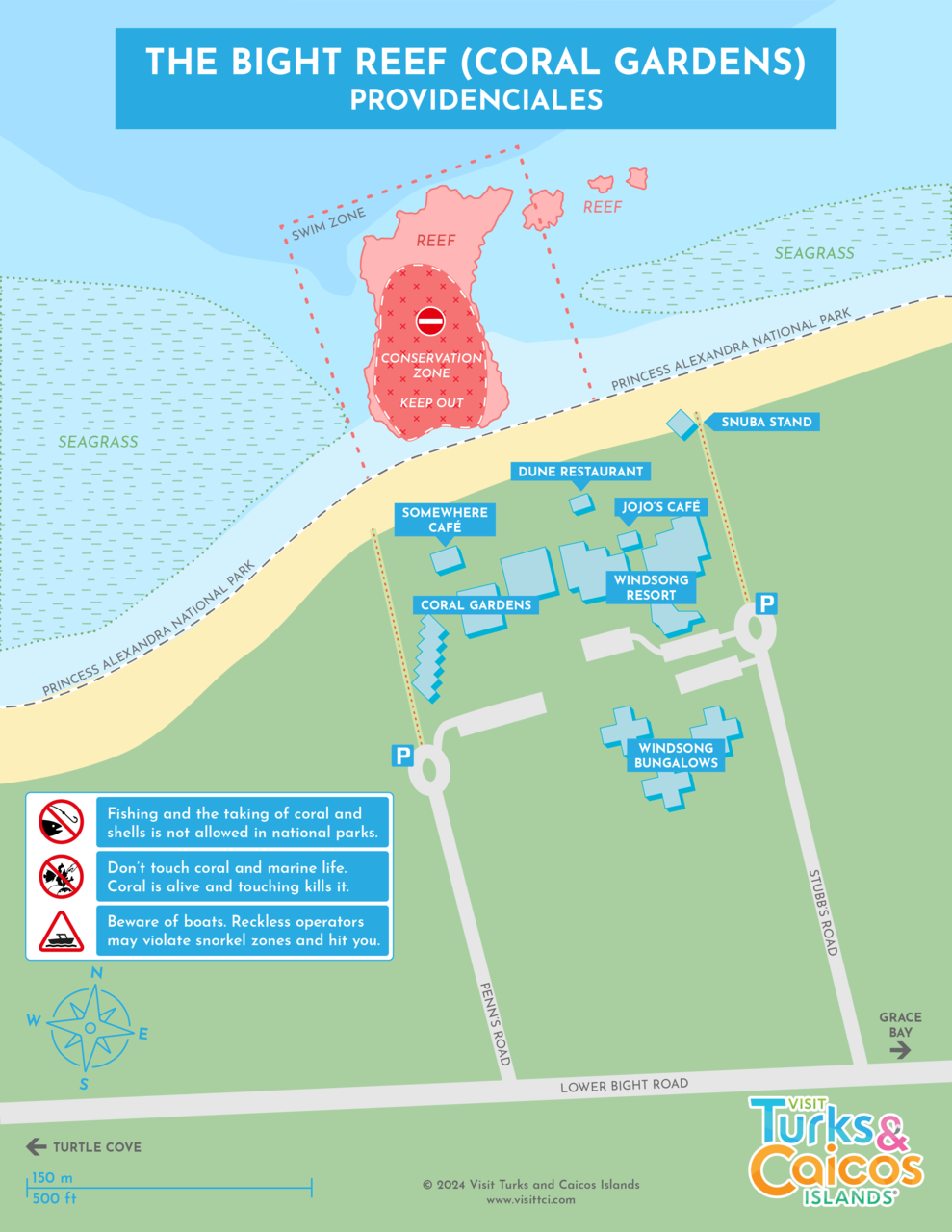The Bight Reef (Coral Gardens) Providenciales

The Bight Reef (also known as Coral Gardens) is an excellent snorkeling reef that begins close to the beach. It is the most popular snorkeling site in the Turks and Caicos Islands.
This is a great location to start your underwater adventures before exploring some of the other beautiful beach reefs around Providenciales.
The Bight Reef is home to a wonderful diversity of fish and marine life, yet the coral isn’t quite as vibrant as what’s seen at the nearby Smith’s Reef or at the reefs typically accessed on snorkeling boat tours.
Unlike the more extensive Smith's Reef, the Bight Reef consists of only one main ridge of coral that extends about 350 feet (107 m) out from the beach. At the far outer reaches of the Bight Reef, the ocean depth becomes 15–20 feet (4.5–6 m).
Beach loungers, umbrellas, snorkel gear, and other water sports equipment are typically available for rent by vendors at the Bight Beach.
The Bight Reef is part of the Princess Alexandra National Park.
Fish and Wildlife

It’s fairly common to spot green turtles, as well as southern brown stingrays and the occasional spotted eagle ray. As they are accustomed to the regular snorkelers, the creatures at the Bight Reef tend to be more approachable than those at other reefs in the Turks and Caicos. If you’re lucky, you may even spot a nurse shark resting on the ocean floor.
The fish sightings include stoplight parrotfish, blue parrotfish, bar jacks, Nassau grouper, queen angelfish, butterflyfish, barracuda, porcupinefish, trumpetfish, squirrelfish, yellowtail snapper, queen triggerfish, sergeant majors, damselfish, scrawled filefish, schoolmasters, trunkfish, and yellow goatfish, to name a few of the species at the reef.
Under the ledges and in crevices are Caribbean spiny lobster, banded coral shrimp, spotted moray eels, and sea cucumbers.
Hard and soft corals can be seen across the entire Bight Reef system, and the most impressive examples are seen at the deeper eastern side of the reef.
Two casual restaurants—Jojo’s Café and Somewhere Café—are located in the dune at the Bight Reef.
Getting to the Bight Reef

It’s very easy to find the beach accesses and coral at the Bight Reef. There are two adjacent accesses, with parking and pedestrian paths that lead to the beach and close to the reef. If you’re staying at a hotel or resort in the Bight or on the western side of Grace Bay, it’s also possible to walk along the beach to the Bight Reef.
Reef etiquette and informational signs can be seen on the beach at the Bight Reef, and red marker buoys can be seen close off the beach, so it’s hard to miss the snorkeling site when on the coast.
Beaches All-Inclusive Resort
If you’re staying at Beaches resort, the reef is a 10-minute walk away to the west. If you’re looking at the ocean in front of the resort, head left down the beach for about 0.5 miles (0.8 km).
Wymara and West Bay Club
If you’re staying at Wymara Resort or West Bay Club, you’ll want to head east (right if you’re looking at the ocean) about 1,500 feet (470 m).
Weather Conditions
Wind and other weather conditions can affect underwater visibility and general snorkeling pleasantness at the Bight Reef. Great visibility and clarity really improve the underwater experience.
Generally, great snorkeling is had when the wind is below 12 mph (19 km/h). Additionally, the incoming or high tide times likewise typically bring better clarity.
While midday and full sun lights up the underwater scene better, some interesting creatures—such as lobsters, lionfish, and marine mollusks—emerge more often in the morning and evening.
Due to damaging behavior by snorkelers and sediment caused by dredging and powerboats, the Bight Reef has declined a bit from what it was 20 years ago. Do not swim inside the circle of buoys that surround part of the reef. This area is a conservation zone with fragile species.
Dangers

By far the greatest danger at the Bight Reef is careless and reckless boat operators. The area has a roped-off swim zone around the reef, yet small speedboats offering tubing and wake rides tend to travel at excessive speeds directly outside of this zone. Along with being dangerous, these boats also churn up sediment and reduce visibility in the water.
Although not much of a threat, the occasional lionfish is something to be aware of. An invasive predatory species from the Indo-Pacific, lionfish have venomous spines on their back capable of giving very painful stings, which in the worst case scenarios can cause temporary seizures or paralysis. Fortunately, the lionfish are not aggressive to humans and only sting in defensive situations.
It’s quite uncommon, yet there may be swarms of thimble jellyfish in the Grace Bay Beach and Bight Beach areas at times. If you see these tiny unpleasant creatures, avoid the area.
Currents and underpulls are rarely an issue at the Bight Reef. However, beginners and unsure swimmers should consider using a snorkeling vest. As with any location, strong winds or rough conditions can make snorkeling unpleasant and difficult. If there is a current present, it usually travels parallel with the shore. If you’re in such water movement, it typically makes sense to swim toward shore, and not attempt to swim against the current. Once back on the beach, it’s easy to walk back to your starting point.

Bight Reef Beach Accesses
Two lanes lead to the Bight Reef off Lower Bight Road, the route that leads between Grace Bay and Turtle Cove. When looking for the two lanes that lead to the beach, it’s easier to watch for the signs for the two adjacent resorts, Coral Gardens Resort and the Windsong, rather than the relatively unobtrusive Princess Alexandra National Park beach access signs.
The Coral Gardens Beach Access off Penn’s Road is on the western side of the reef, and the footpath to the beach here leads directly to the start of the snorkeling reef. The Stubb's Road Beach Access on Stubb’s Road is on the eastern side of the reef, and is usually a little less crowded. Free parking can be found along both Penn’s Road and Stubb’s Road.
